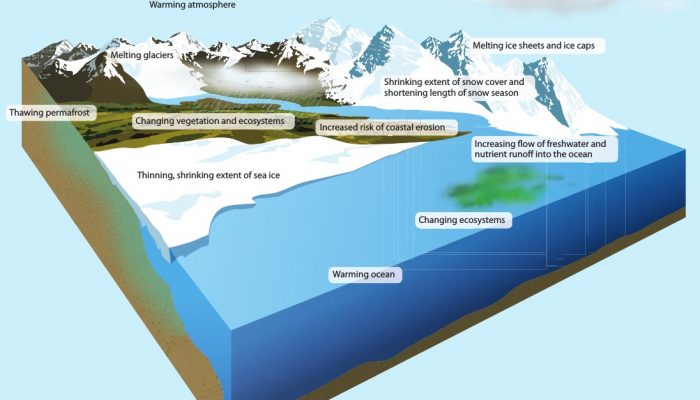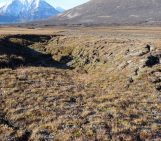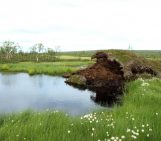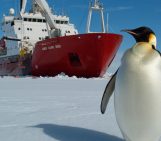
The Arctic is changing rapidly and nothing indicates a slowdown of these changes in the current context. The Snow, Water, Ice and Permafrost in the Arctic (SWIPA) report published by the Arctic Monitoring and Assessment Program (AMAP) describes the present situation and the future evolution of the Arctic, the local and global implications, and mitigation and adaptation measures. The report is based on research conducted between 2010 and 2016 by an international group of over 90 scientists, experts, and members of Arctic indigenous communities. As such, the SWIPA report is an IPCC-like assessment focussing on the Arctic. Our Image of the Week summarizes the main changes currently happening in the Arctic regions.
What is happening to Arctic climate currently?
The SWIPA report confirms that the Arctic is warming much faster than the rest of the world, i.e. more than twice the global average for the past 50 years (Fig. 2). For example, Arctic surface air temperature in January 2016 was 5°C higher than the average over 1981-2010. This Arctic amplification is due to a variety of climate feedbacks, which amplify the current warming beyond the effects caused by increasing greenhouse gas concentrations alone (see the SWIPA report, Pithan & Mauritsen (2014) and this previous post for further information).

Fig.2: Anomaly of Arctic and global annual surface air temperatures relative to 1981-2010 [Credit: Fig. 2.2 of AMAP (2017), revised from NOAA (2015)].
This fast Arctic warming has led to the decline of the ice cover over both the Arctic Ocean (sea ice) and land (Greenland Ice Sheet and Arctic glaciers).
For sea ice, not only the extent has dramatically decreased over the past decades (see Stroeve et al. 2012 and Fig. 3), but also the thickness (see Lindsay & Schweiger, 2015). Most Arctic sea ice is now first-year ice, which means that it grows in autumn-winter and melts completely during the following spring-summer. In contrast, the multiyear sea-ice cover, which is ice that has survived several summers, is rapidly disappearing.

Fig. 3: Arctic sea-ice extent in March and September from the National Snow and Ice Data Center (NSIDC) and the Ocean and Sea Ice Satellite Application Facility (OSI SAF) [Credit: Fig. 5.1 of AMAP (2017)].
In terms of land ice, the ice loss from the Greenland Ice Sheet and Arctic glaciers has been accelerating in the recent decades, contributing a third of the observed global sea-level rise. Another third comes from ocean thermal expansion, and the remainder comes from the Antarctic Ice Sheet, other glaciers around the world, and terrestrial storage (Fig. 4, see also this previous post and Chapter 13 of the last IPCC report).

Fig. 4: Global sea-level rise contribution from the Arctic components (left bar), Antarctic Ice Sheet and other glaciers (middle-left bar), terrestrial storage (middle-right bar) and ocean thermal expansion (right bar) [Credit: Fig. 9.3 of AMAP (2017)].
Besides contributing to rising sea levels, land-ice loss releases freshwater into the Arctic Ocean. Compared with the 1980-2000 average, the freshwater volume in the upper layers of the Arctic Ocean has increased by more than 11%. This could potentially affect the ocean circulation in the North Atlantic through changes in salinity (see this previous post).
Other changes currently occurring in the Arctic include the decreasing snow cover, thawing permafrost, and ecosystem modifications (e.g. occurrence of algal blooms, species migrations, changing vegetation, and coastal erosion). You can have a look at the main Arctic changes in our Image of the Week.
Where are we going?
The SWIPA report highlights that the warming trends in the Arctic will continue, even if drastic greenhouse gas emission cuts are achieved in the near future. For example, mean Arctic autumn and winter temperatures will increase by about 4°C in 2040 compared to the average over 1981-2005 according to model projections (Fig. 5, right panel). This corresponds to twice the increase in projected temperature for the Northern Hemisphere (Fig. 5, left panel).

Fig. 5: Autumn-winter (NDJFM) temperature changes for the Northern Hemisphere (left) and the Arctic only (right) based on 36 global climate models, relative to 1981-2005, for two emission scenarios [Credit: Fig. 2.15 of AMAP (2017)].
This Arctic amplification leads to four main impacts:
-
The Arctic Ocean could be ice-free in summer by the late 2030s based on extrapolated observation data. This is much earlier than projected by global climate models.
-
Permafrost extent is projected to decrease substantially during the 21st Century. This would release large amounts of methane in the atmosphere, which is a much more powerful greenhouse gas than carbon dioxide.
-
Mean precipitation and daily precipitation extremes will increase in a warming Arctic.
-
Global sea level will continue to rise due to melting from ice sheets and glaciers, ocean thermal expansion, and changes in terrestrial storage. However, uncertainties remain regarding the magnitude of the changes, which is linked to the different emission scenarios and the type of model used.
What are the implications?
A potential economic benefit to the loss of Arctic sea ice, especially in summer, is the creation of new shipping routes and access to untapped oil and gas resources. However, besides this short-term positive aspect of Arctic changes, many socio-economic and environmental drawbacks exist.
The number of hazards has been rising due to Arctic changes, including coastal flooding and erosion, damage to buildings, risks of avalanches and floods from rapid Arctic glacier melting, wildfires, and landslides related to thawing permafrost. Furthermore, Arctic changes (especially sea-ice loss) may also impact the climate at mid-latitudes, although many uncertainties exist regarding these possible links (see Cohen et al., 2014).
What can we do?
The SWIPA report identifies four action steps:
-
Mitigating climate change by decreasing greenhouse gas emissions. Implementing the Paris Agreement would allow stabilizing the Arctic temperatures at 5-9°C above the 1986-2005 average in the latter half of this century. This would also reduce the associated changes identified on our Image of the Week. However, it is recognized that even if we implement the Paris Agreement, the Arctic environment of 2100 would be substantially different than that of today.
-
Adapting to impacts caused by Arctic changes.
-
Advancing our understanding of Arctic changes through international collaboration, exchange of knowledge between scientists and the general public, and engagement with stakeholders.
-
Raising public awareness by sharing information about Arctic changes.
Further reading
- AMAP (2017). Snow, Water, Ice and Permafrost in the Arctic (SWIPA) 2017. Arctic Monitoring and Assessment Programme (AMAP), Oslo, Norway. xiv + 269 pp.
- Image of the Week – Climate Change and disappearing ice
- Image of the Week – The warming effect of the decline of Arctic Sea Ice
- Image of the Week – The ups and downs of sea ice
- Sea level for dummies
- Water masses for dummies
Edited by Scott Watson and Clara Burgard
 David Docquier is a post-doctoral researcher at the Earth and Life Institute of Université catholique de Louvain (UCL) in Belgium. He works on the development of processed-based sea-ice metrics in order to improve the evaluation of global climate models (GCMs). His study is embedded within the EU Horizon 2020 PRIMAVERA project, which aims at developing a new generation of high-resolution GCMs to better represent the climate.
David Docquier is a post-doctoral researcher at the Earth and Life Institute of Université catholique de Louvain (UCL) in Belgium. He works on the development of processed-based sea-ice metrics in order to improve the evaluation of global climate models (GCMs). His study is embedded within the EU Horizon 2020 PRIMAVERA project, which aims at developing a new generation of high-resolution GCMs to better represent the climate.



